We’re going to start posting complete transcripts of past episodes of Light Hearted, beginning with this one — episode #1. This one features an interview with the two-time Caldecott Medal winning children’s book author and illustrator Sophie Blackall, mainly focusing on her 2018 book Hello Lighthouse. Even if you’ve listened to it before, we think you’ll enjoy reading it. If you want to listen to it again (or for the first time), you can use the player here. If you want to go directly to the interview, it starts about eight minutes into the program.
OPENING MUSIC
JEREMY D’ENTREMONT
You are listening to Light Hearted, the official podcast of the United States Lighthouse Society. My name is Jeremy D’Entremont. Welcome. In this and future episodes of this podcast, we’ll be exploring all kinds of subjects related to lighthouses: history, preservation, technology, navigation, the arts, and who knows what else. Basically anything and everything that ties in with the subject of lighthouses in some way. As I said, this is the official podcast of the United States Lighthouse Society. The society was founded as a nonprofit organization in 1984 and publishes a quarterly journal, the Keeper’s Log, and also offers domestic and international tours, which we’ll be talking about in future editions of this podcast. You can learn all about the USLHS by going to the website, at uslhs.org—that’s uslhs.org—and also to the society’s social media pages on Facebook, Twitter, and Instagram.
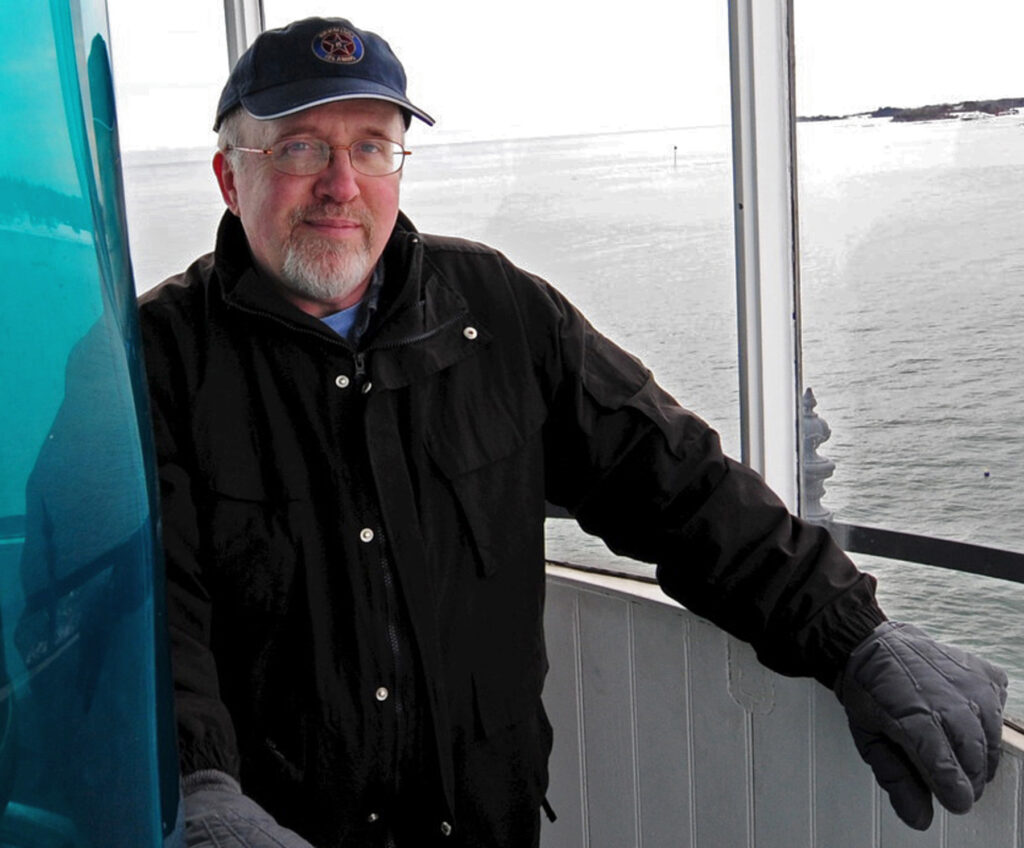
Let me say right at the start that I’m very happy to have this opportunity to represent the U.S. Lighthouse Society on this podcast. I want to make it clear that any opinions I state are my own and not necessarily those of the U.S. Lighthouse Society. In my 30 years or so of being involved with lighthouses, it has been a privilege to meet many fascinating people and to make a lot of friends. I’ll be talking to many of those people in the interviews we’ll be hearing in this podcast and I’m sure I’ll be making a lot of new friends along the way as well. We’re going to have a trivia question in today’s show with prizes for the first people to get the correct answer. I am not going to tell you where in the show we’ll be asking the questions so you have to listen if you want to win.
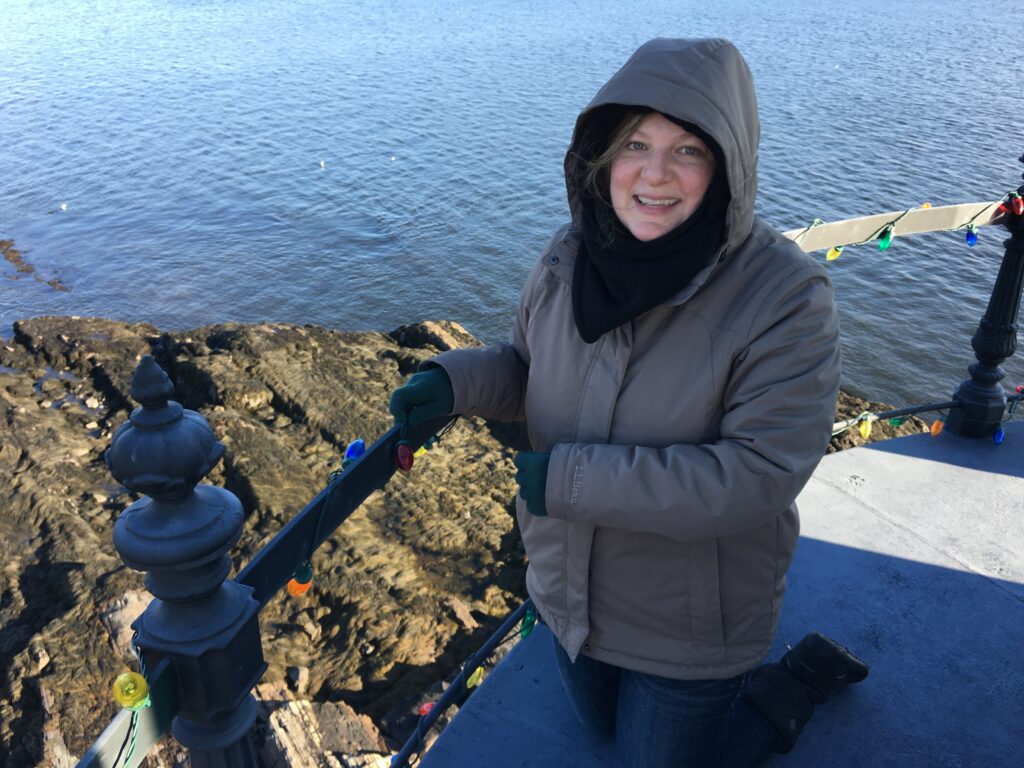
We are recording the first episode of Light Hearted at the Exeter Inn in beautiful Exeter, New Hampshire, and I want to thank the management of the Exeter Inn. And speaking of friends, my cohost for this first episode is Cindy Johnson. Cindy is the operations manager of Friends of Portsmouth Harbor Lighthouses, which is a chapter of the American Lighthouse Foundation, another nonprofit organization that works for lighthouse preservation. So Cindy, can you tell us a little bit about what got you interested in lighthouses?
CINDY JOHNSON
Sure. Thanks for having me, Jeremy. So I’ve lived in different parts of the country, but I’ve always been by the coast and for me, New England in particular I find really full of history and charm and that includes lighthouses. They’re beautiful structures in the most scenic places. And it’s been really fascinating to learn about the people involved, the lighthouse keepers and their families.
JEREMY
Well, thanks again, thanks for being with me today, Cindy. In a few minutes we’re going to listen to an interview with children’s book author Sophie Blackall, all about her book. Hello Lighthouse. But first we have a segment about lighthouse history. Yay! Starting now and over the next few editions of this podcast, we’re going to explore the history of the world’s lighthouses. To get started, let’s go back to the very beginning before lighthouses existed. The idea of light or fire cutting through the darkness is a common one in various cultures and religions. Following as an excerpt from an essay by the engineer Sri Priya Sundararajan, she kindly gave her permission for us to read this excerpt.
CINDY
“Since immemorial times, light has offered comfort and assurance, inspiration and guidance, and has shaped how human beings understand the world around them. The cultural myths of several nations center on a period of darkness dispelled by the generation of light in an uncanny parallel to the big bang theory. In the creation myth of Hinduism, primordial darkness gives way to the universe as we know it. In Greek mythology, Prometheus stole fire from the gods out of love for human beings, which allowed man to ward off danger and provide a means to sustain. In the myths of the Inuit First Nations, the Northern Lights represent the souls of loved ones passed on playing a celestial game of football while offering comfort and connection to those they left behind. Universally light provides a sense of connection between heaven and earth. Light touches our bodies and empowers our souls.”
JEREMY
In early human history, darkness was a very scary thing. Wild animals and our enemies could kill us more easily in the darkness. We hid in caves and waited for the light. For many thousands of years. The availability of light governed our lives.
CINDY
We eventually learned to light fires to eliminate our caves or campgrounds at night, but as we started venturing out on the seas in boats, the idea of being out in the darkness was very scary.
JEREMY
The earliest record of boats carrying goods for trade is around 3,500 BC. The first navigators traveled mainly during the day. As mariners ventured out more at night, some learned to plot their course by the movement of the stars and constellations. It’s believed that the ancient Phoenicians were excellent celestial navigators and they completed the first circumnavigation of Africa by around 600 BC.
CINDY
But even with skilled navigators, there was always the danger of running into hidden rocks, shoals, and other obstacles. The origins of the lighthouse go back to simple bonfires built on beaches and hillsides in many cultures around the world. The Greeks built braziers filled with fire and put them on hillsides at the entrances to harbors and along navigation routes.
JEREMY
The Greeks also built some of the earliest structures that can be called lighthouses as early as the fifth century BC, basically columns surmounted by fires. In our next episode of Light Hearted, we’ll talk about the world’s first great lighthouse, the Pharos of Alexandria.
MUSICAL INTERLUDE
JEREMY
Another subject we’ll be exploring in many episodes of Light Hearted is the subject of lighthouses in literature and movies. Lighthouses have long been a popular theme for children’s books and one of the most honored children’s books of 2018 is Hello Lighthouse by Sophie Blackall.
CINDY

(Library of Congress)
Sophie Blackall is an Australian artist and illustrator of children’s books based in Brooklyn, New York. She has illustrated more than 30 books for children. Her work also includes animated television commercials and editorial illustrations for newspapers and magazines. Her books have won many awards and her children’s book Hello Lighthouse, which she wrote and illustrated, won the 2019 Caldecott Medal. The Caldecott is presented each year to the artist of the most distinguished American picture book for children.
JEREMY
I recently had the pleasure of speaking with Sophie Blackall on the phone. Let’s listen to that conversation now.
MUSICAL INTERLUDE
JEREMY
Sophie, thanks so much for speaking with me today.
SOPHIE BLACKALL
I am delighted.
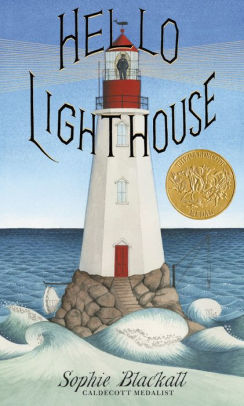
JEREMY
Thanks so much. And congratulations on the Caldecott medal for Hello Lighthouse. It’s a beautiful book.
SOPHIE BLACKALL
Thank you. Thank you.
JEREMY
So this was your second Caldecott medal. Your first was in 2016 for Finding Winnie: The True Story of the World’s Most Famous Bear by Lindsey Mattick. And I understand you’re one of nine illustrators to win multiple Caldecotts. That’s an incredible achievement. Were you surprised to win a second Caldecott?
SOPHIE BLACKALL
You don’t really expect to win one in a lifetime, let alone two. So yes, I was incredibly surprised. It was all the more surreal because I happened to be in Myanmar at the time and with the time difference and everything else, it was an extraordinary phone call to receive and I couldn’t have been happier. I said to somebody, when my second child was born, I was every bit as thrilled as when I had my first child. And you don’t expect to have this much good fortune and joy in a lifetime, but I wouldn’t return it for the world.
JEREMY
So what was it that inspired you to do a book about a lighthouse and a lighthouse keeper?
SOPHIE BLACKALL
I have like most, as I like to think, like most sensible people on the planet, I have always admired and been fascinated by lighthouses. But it was rifling through old prints at a flea market in Brooklyn many years ago. And I saw a cutaway of the Eddystone Lighthouse in Great Britain. And for the first time I was actually looking inside a lighthouse. I had always admired them from a boat or from the shore or from a headland. But to see this cutaway with the rooms and the spiral staircase and to suddenly imagine life within these round rooms, this vertical existence, it created some tiny spark of an idea. I was with a friend at the time and I picked the print up and put it down and picked it up and she said, you should get it.
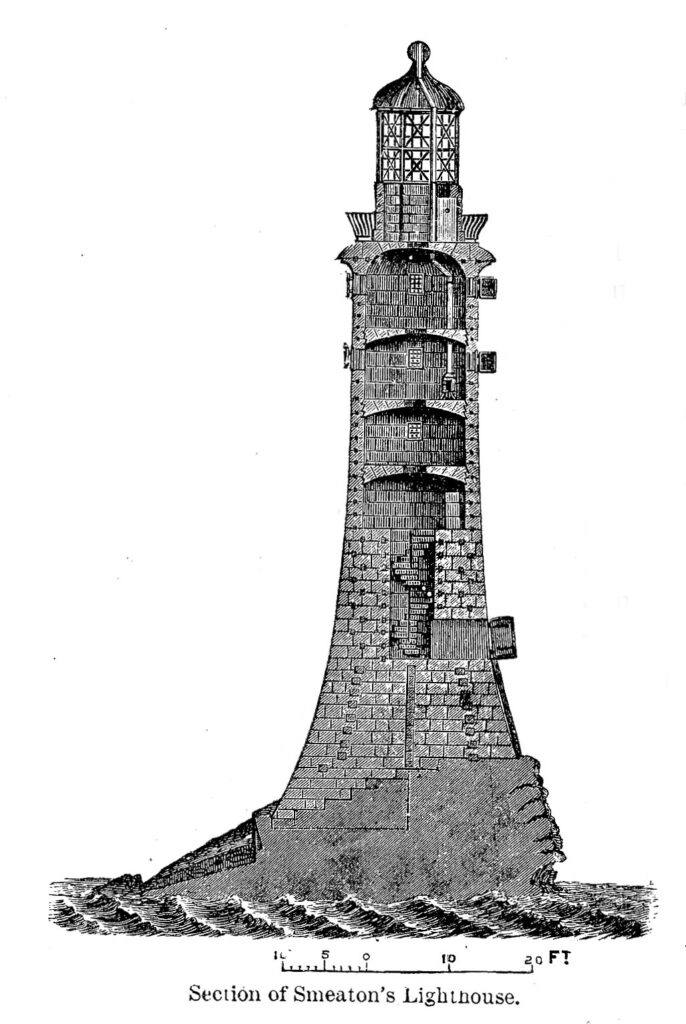
And I said, I don’t know why I’m getting this. I don’t have any wall space in my house to display it. It’s going to go in a drawer. And she said, it’s clearly tugging at you and we shouldn’t ignore things that tug at us. Which I thought was tremendous advice ever since then. Because I did buy it and I did put it in a drawer for at least a couple of years. But then I opened that drawer one day and there it was. And I thought, “Ah, this is the time!” I suddenly saw how it might be a story.
JEREMY
What do you think it is about lighthouses? What makes them so appealing to people, do you think?
SOPHIE BLACKALL
I have now asked this question all over the world. I’ve done a whole lot of school visits, mostly talking to children with this book. And I’m curious too—what is it about lighthouses? And I’ve had as many answers as you can imagine, as people have all sorts of reasons. And they range from those that I share: that lighthouses are majestic and romantic and compelling. But one child said to me what I have come to think of as one of the best definitions of a lighthouse. And he said, “They’re like helpful castles in the sea,” which sums up both the beauty of the form, the structure itself, and also the purpose that they serve, which is this steadfast guidance.
And of course these days it’s more of a symbolic thing than it is practical, because most lighthouses are either automated or not illuminated at all. But they stand as a reminder of this time when we were so dependent upon them and the people who maintain them. They were lights shining out in the deep dark sea. And so (for) sailors on long journeys, I believe they were a sense of not being alone in the world. They were a sense that someone or something was watching over them. And I think they provide that for all of us.
JEREMY
Helpful castles in the sea—I love that. So how have children responded to the book Hello Lighthouse?
SOPHIE BLACKALL
It’s been phenomenal. I confess this was a book that I wanted to make so much for myself that I worried at some point that I had lost sight of children’s interest in it. Some people—like Maurice Sendak famously said, “I make books and then other people tell me they’re for children.” He did not set out to make books for children, but I have always set out to make books for children. They’re incredibly important to me. The way they respond to my books is very important. But I feared with Hello Lighthouse that it became such a personal book that that perhaps they wouldn’t respond to it in the way that I had hoped. Perhaps it was too grown up. It’s about adults more than it is about children. I think it’s quite a romantic story. It’s about life and loss and change and renewal and hope. And these are all quite grown up things in a way.
Until I remembered that they’re also things that children experience. They’re things that we all experience. And so the reality is it’s overwhelming how children have responded. And I’ve gone into schools and a teacher has told me that they have run a competition within the school to have lunch with the author before my visit. And usually they will get a handful of entries and everybody who enters will get to have to get to have lunch. But in this one particular school, almost every child in the elementary school entered and it was—they had to either draw or write a poem or a story, something on a theme of a lighthouse. And the pictures and poems and stories that flooded in, there were hundreds of them. And I read almost all of them and they would just, they were joyous. And it really brought it home that everyone loves lighthouses, but especially children. They are as drawn to them as I am, for their own reasons and for the same ones that I am.
JEREMY
Well that’s great to hear, that children have responded so, so well to it. But I’m sure I’m not the only adult who loves it so much. And you know, I have a pretty big collection of lighthouse children’s books myself and I have to say I love all the details. You included all the very, you know, very nicely developed details in the book. Things like the fog bell, the keeper trimming the wick in the lamp, the details of the spiral stairs and the lighthouse, the very detailed drawing of the Fresnel lens in the lighthouse. You went into the automation of the light towards the end of the book. Your research into lighthouses really shows quite a bit. And you mentioned you were inspired by a cross section of the Eddystone Lighthouse. I was wondering—the lighthouse in the book is a little bit reminiscent of Eddystone Lighthouse, but were you influenced by any other particular lighthouse? Did you base the lighthouse in the book on a particular lighthouse?
SOPHIE BLACKALL
I, well first of all, thank you so much for saying that because I confess, speaking to someone like you who is steeped in decades of lighthouse lore and literature and information. I’m so happy that you think those details are all there. I did do an awful lot of research, but at the same time felt that I was just scratching the surface, that there are, as you know, lots of wonderful museums and archives, and the website of the USLHS—have I got that right?
JEREMY
Yes, you did. U.S. Lighthouse Society. Yeah.
SOPHIE BLACKALL
Those acronyms always throw me. It was, you know, incredibly helpful and is just a wonderful kind of rabbit hole. You can go in there and just go from, from one link to another. And so that was hugely helpful. But even with that there were things that—I was towards the end of the book when I realized that during the daytime that the lens needed to be protected from the sun, that otherwise there was the risk of fires. And so there would be curtains drawn on the inside of the lantern room. And so I had to go back early on, there’s a page where we see the lighthouse, on the windy page. And I had to quickly draw in that lighthouse keeper, pulling the curtains across, inside. So it was very much an ongoing thing until the very last minute, this research and uncovering new information about how the whole lighthouse worked.
But kids love that part of it. They love hearing about winding the clockwork and how often that had to be done and the thought of never having an uninterrupted night’s sleep. They love the bell and the stories of the bell and the foghorns in different kinds of lighthouses and the tenders. How long you would have to wait between their visits, but also how keepers would get from the ship to the lighthouse shore in these treacherous waters with craggy rocks when the boat couldn’t come close enough and they’d have to use a bosun chair or the pulleys and things. You know, that’s just made for children in a way. It’s all so exciting and intriguing and fantastic.
JEREMY
I’m curious, could you say a little bit about the media you use to illustrate Hello Lighthouse? The illustrations I find very precise and delicate and I read somewhere you used Chinese ink and watercolors. Is the Chinese ink thing, is that something that’s unusual at all?
SOPHIE BLACKALL
I think it is a little bit unusual. It’s the way I’ve been working for about 15 years and I discovered it by accident, but I’m sure I’m in no way the only person to use it in this way. I don’t use it in the traditional sense that Chinese calligraphers use it, which is to grind the ink on a stone and then to use a Sumi-e brush or a Chinese calligraphy brush to paint the ink in a deep, rich black line. Instead, I grind the ink on the stone in the same way, but then I use it in more sort of transparent layers to build up the dark tone. And then I use washes of watercolor over the top. So it has the effect a little bit of like tinting an old black and white photograph. And this is just the way I’ve developed my own technique. And it feels like a little bit of magic when the color goes on. It’s always the fun part to watch these black and white pictures sort of come alive, as it were.
JEREMY
Well, it is magic. They’re very beautiful. Would you say that the process of researching and writing and illustrating Hello Lighthouse has made you into more of a lighthouse buff than you were before you started the whole thing?
SOPHIE BLACKALL
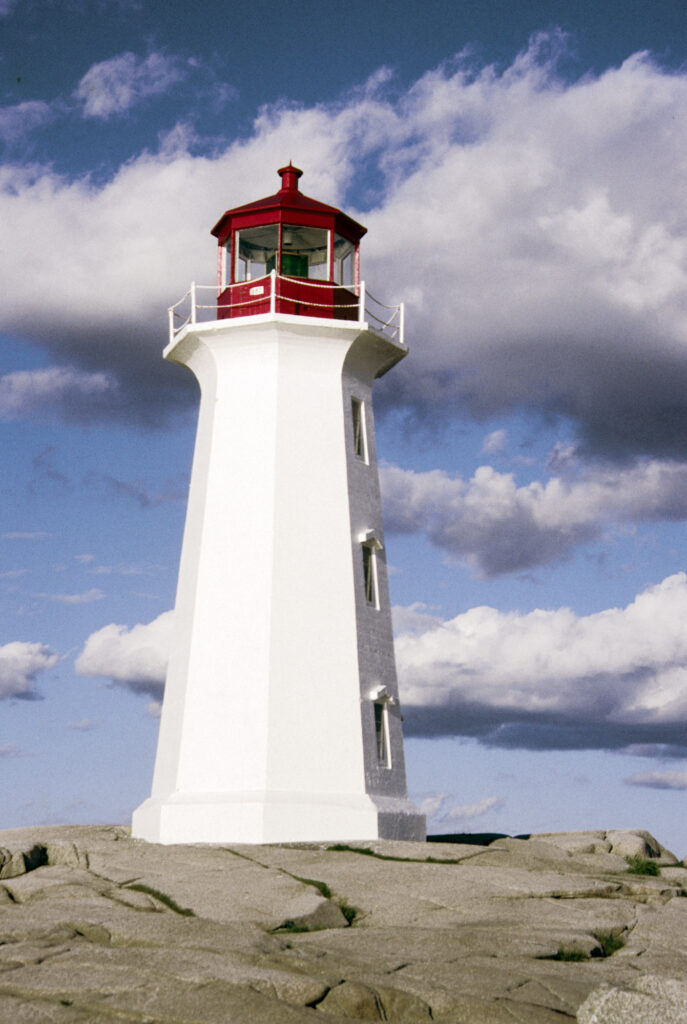
U.S. Lighthouse Society photo
Oh, it’s completely seductive. I realize you actually asked me before if there was a particular lighthouse that the book was based on, and it wasn’t one particular one. I did cheat a little bit and certainly the interior has echoes of Eddystone or those lighthouses built on a rock or a ledge. But the exterior is closer to a few that I visited in Canada, in Newfoundland. It’s a little bit like Peggy’s Cove, which is a fairly famous one I think in Nova Scotia, which I did not visit. But it also is similar to one I did stay in, on Quirpon Island on the northernmost tip of Newfoundland. That had a wooden exterior. The island it was on was, was much bigger than the imaginary rock where I placed it. And also I think these solitary remote rock lighthouses would more likely have had two or three keepers rather than a married couple living there. But for the purposes of my story, I wanted to, to make them the inhabitants, so —
JEREMY
No, I didn’t mind that at all. I realized that you sort of cheated a little bit in that way, but I didn’t mind that at all. And you know, in American lighthouses early on, in the 19th century, they did populate some of those lighthouses with families before they decided it would be a better idea to make them so-called stag stations with males only. So you probably did read that historically there were families in some of those very remote lighthouses. And I think that was true in Europe as well.
SOPHIE BLACKALL
Yes, I mean some you read about had 11 children born in a lighthouse and the one in fact on Quirpon Island had had nine children. And it’s at its base, there’s a tiny white picket fence-surrounded grave. I mean it’s as big as a shoebox and that’s where two of the infants who perished in childbirth were buried at the base of this lighthouse. And that struck a chord immediately and just reminded me as I began to read about so many different lighthouses that all of them were filled with stories of life and stories of loss and of death. And that these stories were all recorded in the logbook, not as stories as such, but as, as just succinct brief notations alongside reports of weather or passing ships or oil usage. And you’d stumbled across something sort of profoundly human and heartbreaking in its kind of brevity.
JEREMY
Sophie Blackall, thanks so much for spending time with us today and congratulations again on the success of Hello Lighthouse.
SOPHIE BLACKALL
Thank you so much. It’s always a joy to talk lighthouses with anybody. Thanks so much for your time.
JEREMY
Okay, it’s time now for our trivia question. Drumroll please. Thank you. Cindy. The first two people to answer this question correctly will win prizes. The first gets a 2019 U.S. Lighthouse Society calendar featuring photographs by 14 talented society members. The second gets a lighthouse illumination DVD. This video takes you on an animated tour through the history of lighthouse illumination. The Fresnel lens is explained in detail, showing the formulas used in the early 1800s along with animated descriptions on the workings of the Fresnel lens. It also includes a lighthearted look at the history of lighthouse illumination that’s a great educational video for children. Okay, Cindy, please tell us this week’s trivia question.
CINDY
Okay. Here’s the question. Who was the first woman lighthouse keeper in North America and where was she the keeper?
JEREMY
Can you repeat the question?
CINDY
Absolutely. One more time. Who was the first woman lighthouse keeper in North America, and where was she the keeper?
JEREMY
And how do people enter to win?
CINDY
They should send their answer in an email to jeremy@uslhs.org
JEREMY
Right. Send your answer in an email to me at jeremy@uslhs.org. Again, that’s J E R E M Y at uslhs dot O R G. jeremy@uslhs.org. Please state that you are answering the trivia question in Light Hearted show one. Again, the trivia question in Light Hearted show one and include your full name and mailing address. Again, the first two people who answer correctly will win a prize.
(26:17)
JEREMY
I was thinking about something just before our recording session today and I want to get serious for just a moment. Not that we’re doing a comedy show here, but I’m going to get a little more serious here for a moment. The past year has been kind of a sad one for the lighthouse preservation community. We’ve lost several people who were very important to us, some of them far too young, including Candace Clifford, Terry Pepper, and Eric Davis. I know that some of you listening knew these people quite well. They were leaders in every sense of the word through their research and writing and simply by being steady role models. There were some of our guiding lights. This points out the fact that the lighthouse preservation world, like the world in general is populated by human beings who are not around forever. We’re always struggling to bring new, younger blood into the field.
And by young blood, I mean under the age of 60. No matter what age you are, if you’re listening and you have an interest in lighthouses, I strongly encourage you to get involved in some way. It doesn’t mean you have to devote your life to lighthouses, although that can be rewarding if you choose to do so. If you live near a lighthouse, maybe you can volunteer once in a while to help out at open houses or to help in a lighthouse museum or a gift shop or to help your local lighthouse organization in some way. If you’re not sure how you can help .contact the U.S. Lighthouse Society or another lighthouse organization and ask what you can do to help. And if you’re a younger person who has ideas about how lighthouses can be better promoted in this age of digital technology and social media, please let us know your ideas. You can email me at jeremy@uslhs.org. Again, jeremy@uslhs.org.
JEREMY
The music you heard of the opening of this podcast and are hearing again now is called Pharos by someone who calls him or herself—or themselves—OWSO. When I found this piece of music, I thought it was perfect. And when I saw the name of the piece was Pharos, which means lighthouse in several languages, I thought it was a bit of serendipity and I knew I had to use it. The guitar interludes you heard between segments are played by my good friend Joe Rivers, who is a musician, audio producer, and engineer par excellence. I think that’s how you pronounce that. I’ve known Joe since my days as an Omnimax projectionist at the Boston Museum of Science. I won’t say how many years ago that was. And Joe is always more than willing to lend a hand at whatever project I’m doing. So thank you very much, Joe. Thank you to Jeff Gales, executive director of the U.S. Lighthouse Society, for his friendship and support in helping to get this podcast off the ground. Thanks also to Maria Guevara, social media consultant of the U.S. Lighthouse Society for her help and support. And I want to single out Tom Wheeler, website guru of the USLHS also for his invaluable help. Thanks also to all the other staff and volunteers of the U.S. Lighthouse Society. And, of course, a big thank you to Cindy Johnson for helping me out today as my cohost. I hope this was fun, Cindy.
CINDY
This was a lot of fun, informative, and I’m looking forward to the Episode Two. So thank you so much for having me, Jeremy.
JEREMY
Well, it was a pleasure. Thank you so much. And of course, many thanks to our guest, Sophie Blackall. And until next time, keep a good light.
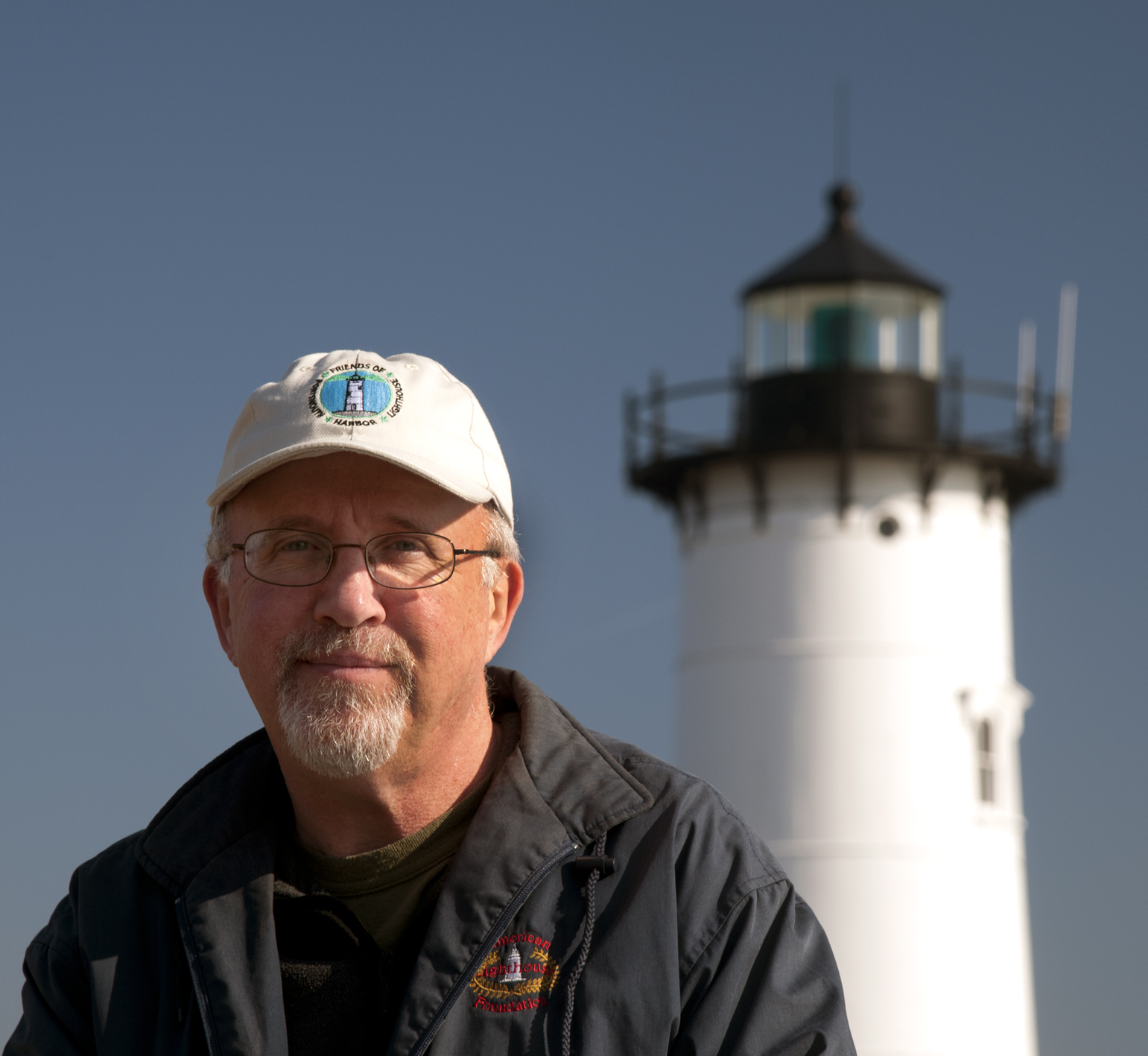
Jeremy D’Entremont is the author of more than 20 books and hundreds of articles on lighthouses and maritime history. He is the president and historian for the American Lighthouse Foundation and founder of Friends of Portsmouth Harbor Lighthouses, and he has lectured and narrated cruises throughout the Northeast and in other regions. He is also the producer and host of the U.S. Lighthouse Society podcast, “Light Hearted.” He can be emailed at Jeremy@uslhs.org

